Falcon Northwest FragBox SLI: Dare to Dream
by Jarred Walton on May 3, 2006 9:00 AM EST- Posted in
- Systems
Construction and Assembly
Still too expensive for you? There's an alternative you might consider if you really like the FragBox case. Falcon offers the FragBox as a DIY chassis for $299, or you can get it with a 600W modular PSU (with a "short cable" kit) for $518. Either way, you get the case as well as cold cathode lighting setup (including an inverter for the lights). Note that if you go the DIY route, you can only get the "FragBox" faceplate and not the "Falcon Northwest" option, which makes sense. Exotix paint jobs are also not offered for the DIY setup.
The case and PSU are made by SilverStone, a company known for building high quality cases. Add in the EVGA SLI motherboard and you're looking at about $700 total for a "barebones" configuration. If you really like the looks but you don't want to pay the price premium - not that $300 for a chassis is cheap, of course, but it's not too bad all things considered - you can buy the DIY kit and add your own modular ATX PSU and motherboard purchased at any of the typical online resellers. That will cut around $125 from the price of the barebones, though whether or not you're getting equivalent quality is up for debate. If you compare that price with the Shuttle SN26P and the Monarch Hornet Pro, the FragBox SLI DIY system is pretty competitive. Finally, you can also go with the SilverStone SG01 for $150 - that's the basis of the FragBox design. At that point, you lose the lights, acrylic face plate, side windows, and carrying handle. It's still a reasonable uATX case, but it's certainly not going to turn heads like the FragBox.
How does the system work as a barebones offering? First, it has to be said that the case isn't super easy to work with, but any competent enthusiast will be able to handle it. Falcon makes no claims about offering a simple-to-assemble barebones - quite the contrary. From their website: "Small Form Factors are by nature not as easy to work in as towers. There's not much room for knuckles, and sometimes a part will need to be removed to access another part. Patience is important." That pretty much sums up the situation. Once the system is properly assembled, you really don't have to worry anymore about how difficult the assembly process might have been. It's slightly more difficult than working with a spacious tower or mid-tower ATX case, but it shouldn't take more than an hour or two to put everything together. If you're the type of person that frequently upgrades components, the case is certainly not geared towards making your life easier; the more common infrequent upgraders will be far more concerned with appearance and performance than ease of assembly.
For those thinking of going the DIY route, we did take the time to dismantle the case, swap some components, and take some pictures. Here's a brief commentary on the process, as well as plenty of images. Larger 1280x960 images are available for the interested, but be warned that they weigh in at 150-200 KB each. We did not completely dismantle the system, as you will see in the images, but we did get down to the point where the only installed components remaining were the motherboard and a few other minor peripherals. You can also see where the wiring was placed by Falcon, which you may find useful if you're trying to assemble a system yourself.
Starting with the power supply, this is a full-size ATX unit. As you can see, it's also a modular power supply, although most of the cables are used for the FragBox SLI configuration we were sent. We mentioned before that this is a 600W power supply, and judging by the way this is a true 600W unit, and not one that simply makes that claim. The PSU has a large 120 mm fan, and the rear of the PSU has hexagonal perforations that allow for good airflow. In use, the power supply is relatively quiet, although as we'll see later this system as a whole certainly isn't silent.
A hard drive tray sits at the front of the case and can be removed for easier installation of the drives. More importantly for the high-end users, the hard drive tray is actively cooled by an 80mm fan, helping to reduce concern for data loss when running dual HDD configurations. This is particularly important if you plan on running RAID 0 - and we would still advise you to make frequent backups in that case. Once everything is installed, the various wires and cables tend to restrict airflow around the hard drives, but the active cooling should compensate for that.
Here you can see the shots of the system in a mostly disassembled state. You can already see that the number of wires coming off the power supply requires a lot of effort to fit into a case this small. Falcon lists the power supply as coming with a "short cable kit", but even then there's a lot of wires to deal with.
With just the motherboard installed, access to the CPU socket is relatively unrestricted. A support beam does run across the top of the case, but it doesn't get in the way. Considering that this is supposed to be something of a "small form factor" computer, you might be surprised at just how large your heatsink can be. Falcon ships prebuilt systems with Zalman CNPS7000 copper cooler. It's a relatively tight fit once everything is installed, as you can see from the images, but the Zalman cooler should keep temperatures lower as well as help to regulate noise levels. One issue that you might have with the Zalman heatsink comes from Falcon's top-end 1GB memory modules. They use Corsair TwinX 2048MB 3500LL Pro modules - complete with flashing lights - and due to their taller than average height and the large Zalman HSF, you can't install more than two DIMMs. FNW does give you the option of using some slightly cheaper and slightly lower performing Corsair TwinX 2048MB PC3200 modules, however. That As the move to Windows Vista and potentially a 64-bit OS and applications will make 4GB of RAM a conceivable upgrade during the life of the system, we would recommend avoiding the 3500LL Pro memory. Ideally, Falcon Northwest will offer another high-performance RAM option in the future -- or you could always just buy your own RAM when it comes time to upgrade.
Still too expensive for you? There's an alternative you might consider if you really like the FragBox case. Falcon offers the FragBox as a DIY chassis for $299, or you can get it with a 600W modular PSU (with a "short cable" kit) for $518. Either way, you get the case as well as cold cathode lighting setup (including an inverter for the lights). Note that if you go the DIY route, you can only get the "FragBox" faceplate and not the "Falcon Northwest" option, which makes sense. Exotix paint jobs are also not offered for the DIY setup.
The case and PSU are made by SilverStone, a company known for building high quality cases. Add in the EVGA SLI motherboard and you're looking at about $700 total for a "barebones" configuration. If you really like the looks but you don't want to pay the price premium - not that $300 for a chassis is cheap, of course, but it's not too bad all things considered - you can buy the DIY kit and add your own modular ATX PSU and motherboard purchased at any of the typical online resellers. That will cut around $125 from the price of the barebones, though whether or not you're getting equivalent quality is up for debate. If you compare that price with the Shuttle SN26P and the Monarch Hornet Pro, the FragBox SLI DIY system is pretty competitive. Finally, you can also go with the SilverStone SG01 for $150 - that's the basis of the FragBox design. At that point, you lose the lights, acrylic face plate, side windows, and carrying handle. It's still a reasonable uATX case, but it's certainly not going to turn heads like the FragBox.
How does the system work as a barebones offering? First, it has to be said that the case isn't super easy to work with, but any competent enthusiast will be able to handle it. Falcon makes no claims about offering a simple-to-assemble barebones - quite the contrary. From their website: "Small Form Factors are by nature not as easy to work in as towers. There's not much room for knuckles, and sometimes a part will need to be removed to access another part. Patience is important." That pretty much sums up the situation. Once the system is properly assembled, you really don't have to worry anymore about how difficult the assembly process might have been. It's slightly more difficult than working with a spacious tower or mid-tower ATX case, but it shouldn't take more than an hour or two to put everything together. If you're the type of person that frequently upgrades components, the case is certainly not geared towards making your life easier; the more common infrequent upgraders will be far more concerned with appearance and performance than ease of assembly.
For those thinking of going the DIY route, we did take the time to dismantle the case, swap some components, and take some pictures. Here's a brief commentary on the process, as well as plenty of images. Larger 1280x960 images are available for the interested, but be warned that they weigh in at 150-200 KB each. We did not completely dismantle the system, as you will see in the images, but we did get down to the point where the only installed components remaining were the motherboard and a few other minor peripherals. You can also see where the wiring was placed by Falcon, which you may find useful if you're trying to assemble a system yourself.
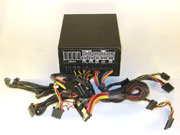 |
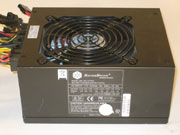 |
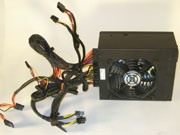 |
| Click to enlarge | ||
Starting with the power supply, this is a full-size ATX unit. As you can see, it's also a modular power supply, although most of the cables are used for the FragBox SLI configuration we were sent. We mentioned before that this is a 600W power supply, and judging by the way this is a true 600W unit, and not one that simply makes that claim. The PSU has a large 120 mm fan, and the rear of the PSU has hexagonal perforations that allow for good airflow. In use, the power supply is relatively quiet, although as we'll see later this system as a whole certainly isn't silent.
 |
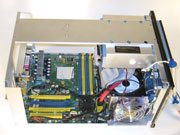 |
| Click to enlarge | |
 |
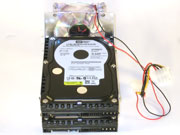 |
| Click to enlarge | |
A hard drive tray sits at the front of the case and can be removed for easier installation of the drives. More importantly for the high-end users, the hard drive tray is actively cooled by an 80mm fan, helping to reduce concern for data loss when running dual HDD configurations. This is particularly important if you plan on running RAID 0 - and we would still advise you to make frequent backups in that case. Once everything is installed, the various wires and cables tend to restrict airflow around the hard drives, but the active cooling should compensate for that.
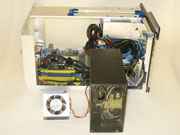 |
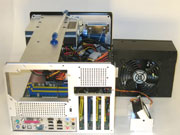 |
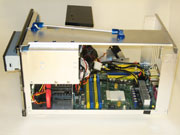 |
| Click to enlarge | ||
Here you can see the shots of the system in a mostly disassembled state. You can already see that the number of wires coming off the power supply requires a lot of effort to fit into a case this small. Falcon lists the power supply as coming with a "short cable kit", but even then there's a lot of wires to deal with.
 |
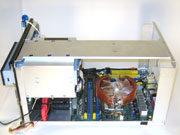 |
 |
| Click to enlarge | ||
With just the motherboard installed, access to the CPU socket is relatively unrestricted. A support beam does run across the top of the case, but it doesn't get in the way. Considering that this is supposed to be something of a "small form factor" computer, you might be surprised at just how large your heatsink can be. Falcon ships prebuilt systems with Zalman CNPS7000 copper cooler. It's a relatively tight fit once everything is installed, as you can see from the images, but the Zalman cooler should keep temperatures lower as well as help to regulate noise levels. One issue that you might have with the Zalman heatsink comes from Falcon's top-end 1GB memory modules. They use Corsair TwinX 2048MB 3500LL Pro modules - complete with flashing lights - and due to their taller than average height and the large Zalman HSF, you can't install more than two DIMMs. FNW does give you the option of using some slightly cheaper and slightly lower performing Corsair TwinX 2048MB PC3200 modules, however. That As the move to Windows Vista and potentially a 64-bit OS and applications will make 4GB of RAM a conceivable upgrade during the life of the system, we would recommend avoiding the 3500LL Pro memory. Ideally, Falcon Northwest will offer another high-performance RAM option in the future -- or you could always just buy your own RAM when it comes time to upgrade.










32 Comments
View All Comments
segagenesis - Wednesday, May 3, 2006 - link
Obviously this wont be cheap, but what an interesting feat of engineering. For a SFF computer this should literally have flames shooting out the back.Gary Key - Wednesday, May 3, 2006 - link
If they had utilized a Pentium 955EE it would have had flames coming out from all directions. :) Just kidding, not really, but we found it amazing how well this case design took thermal requirements under consideration when utilizing SLI and a FX series processor.